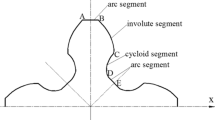Abstract
The smoothness and continuity of the tool path are crucial in high-quality machining. However, many tool paths are described using only line segments (G01), which inevitably cause discontinuities between blocks. Such discontinuity leads to vibration and feed rate fluctuation, which ultimately leads to a poor surface finish. This study proposes a novel input shaping-based corner rounding algorithm that ensure machining accuracy and vibration suppression. Input shaping is a model-based, robust vibration suppression solution, and it has been widely used in many applications. However, input shaping also distorts the original trajectory, which limits its usage in multiaxis systems. To ensure position accuracy, the corner rounding algorithm proposed in this study includes the position deviation regulation module and the distortion compensation module. The position deviation regulation module limits the position deviation due to corner rounding within the threshold while the distortion compensation scheme compensates for the distortion due to input shaping. The proposed algorithm has been verified via simulations and experiments using a two-degrees of freedom (DOF) Cartesian machine.
Similar content being viewed by others
References
Heng M, Erkorkmaz K (2010) Design of a NURBS interpolator with minimal feed fluctuation and continuous feed modulation capability. Int J Mach Tools Manuf 50(3):281–293
Lee A-C, Lin M-T, Pan Y-R, Lin W-Y (2011) The feedrate scheduling of NURBS interpolator for CNC machine tools. Comput Aided Des 43(6):612–628
Erkorkmaz K, Yeung C-H, Altintas Y (2006) Virtual CNC system. Part II. High speed contouring application. Int J Mach Tools Manuf 46(10):1124–1138
Zhao H, Zhu L, Ding H (2013) A real-time look-ahead interpolation methodology with curvature-continuous B-spline transition. Int J Mach Tools Manuf 65:88–98
Walton D, Meek D (2009) G2 blends of linear segments with cubics and Pythagorean-hodograph quintics. Int J Comput Math 86:1498–1511
Bi Q, Yuhan W, Zhu L, Ding H (2011) A practical continuous-curvature Bezier transition algorithm for high speed machining of linear tool path. The paper presented at the Proceedings of the 4th International Conference on Intelligent Robotics and Applications, Aachen, Germany, Dec, 6–8
Tulsyan S, Altintas Y (2015) Local toolpath smoothing for five-axis machine tools. Int J Mach Tools Manuf 96:15–26
Sencer B, Ishizaki K, Shamoto E (2015) A curvature optimal sharp corner smoothing algorithm for high-speed feed motion generation of NC systems along linear tool paths. Int J Adv Manuf Technol 76:1977–1992
Yang J, Yuen A (2017) An analytical local corner smoothing algorithm for five-axis CNC machining. Int J Mach Tools Manuf 123:22–35
Bi Q, Shi J, Wang Y, Zhu L, Ding H (2015) Analytical curvature-continuous dual-Bezier corner transition for five-axis tool path. Int J Mach Tools Manuf 91:96–108
Xu F, Sun Y (2018) A circumscribed corner rounding method based on double cubic B-splines for a five-axis linear tool path. Int J Adv Manuf Technol 94:451–462
Dong J, Wang T, Li B, Ding Y (2014) Smooth feedrate planning for continuous short line tool path with contour error constraints. Int J Mach Tools Manuf 76:1–12
Beudaert X, Lavernhe S, Tournier C (2013) 5-Axis local corner rounding of linear tool path discontinuities. Int J Mach Tools Manuf 73:9–16
Tajima S, Sencer B (2016) Kinematic corner smoothing for high speed machine tools. Int J Mach Tools Manuf 108:27–43
Singer N, Seering W (1990) Preshaping command inputs to reduce system vibrations. J Dyn Syst Meas Control 112(1):76–82
Singer N, Singhose W, Seering W (1999) Comparison of filtering methods for reducing residual vibrations. Eur J Control 5(2–4):208–218
Singhose W, Porter L, Kenison M, Kriikku E (2000) Effects of hoisting on the input shaping control of gantry cranes. Control Eng Pract 8(10):1159–1165
Kamel A, Lange F, Hirzinger G (2008) New aspects of input shaping control to damp oscillations of a compliant force sensor. Paper presented at the Proceedings of IEEE International Conference on Robotics and Automation, Pasadena, May, 19–23
Malzahn J, Ruderman M, Phung A S, Hoffmann F, Bertram T (2010) Input shaping and strain gauge feedback vibration control of an elastic robotic arm. The paper presented at the Conference on Control and Fault Tolerant Systems, Nice, Oct, 6–8
Khoshdarregi MR, Tappe S, Altintas Y (2014) Integrated five-axis trajectory shaping and contour error compensation for high-speed CNC machine tools. IEEE ASME Trans Mechatron 19(6):1859–1871
Palaez G, Palaez G, Perez JM, Vizan A, Bautista E (2005) Input shaping reference commands for trajectory following Cartesian machine. Control Eng Pract 13(8):941–958
Singhose WE, Seering WP, Singer N (1997) Time-optimal negative input shapers. J Dyn Syst Meas Control 119(2):198–205
Erkormaz K, Altintas Y (2001) High speed CNC system design part I: jerk limited trajectory generation and quantic spline interpolation. Int J Mach Tools Manuf 41(9):1323–1345
Zhang K, Yuan C-M, Gao X-S, Li H (2012) A greedy algorithm for feedrate planning of CNC machines along curved tool path with confined jerk. Robot Comput Integr Manuf 28(4):472–483
Macfarlane SE, Croft EA (2003) Jerk-bounded manipulator trajectory planning: design for real-time applications. IEEE Trans Robot Autom 19(1):42–52
Altintas Y, (2012) Manufacturing automation: metal cutting mechanics, machine tool vibrations and CNC design. Cambridge University Press, New York
Han G-C, Kim D-I, Kim H-G, Nam K, Choi B-K, Kim S-K (1999) A high speed machining algorithm for CNC machine tools. The paper presented at the Proceedings of IEEE the 25th Annual Conference of the Industrial Electronics Society, San Jose, CA, USA, Nov, 29-Dec, 3
Shiller Z, Lu H-H (1999) Robust computation of path constrained time optimal motions. The paper presented at the Proceedings of IEEE International Conference on Robotics and Automation, Cincinnati, May, 13–18
Madisetti V (2009) The digital signal processing handbook. CRS Press, Boca Raton
Funding
This research was supported by Korea Electrotechnology Research Institute (KERI) Primary research program through the National Research Council of Science & Technology (NST) funded by the Ministry of Science, ICT and Future Planning (MSIP) (No. 17-12-N0101-22).
Author information
Authors and Affiliations
Corresponding author
Rights and permissions
About this article
Cite this article
Cho, C.N., Song, Y.H., Lee, C.H. et al. Input shaping-based corner rounding algorithm for machining short line segments. Int J Adv Manuf Technol 97, 105–116 (2018). https://doi.org/10.1007/s00170-018-1922-0
Received:
Accepted:
Published:
Issue Date:
DOI: https://doi.org/10.1007/s00170-018-1922-0




